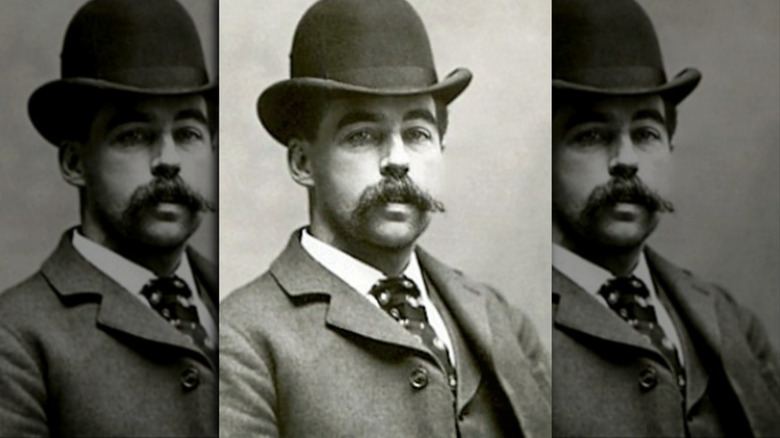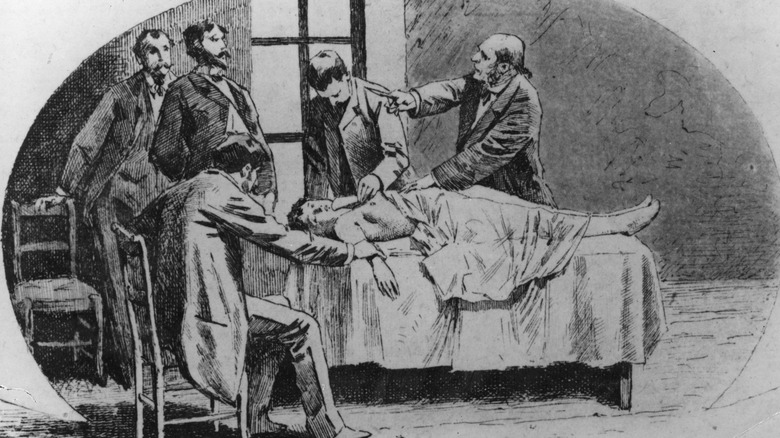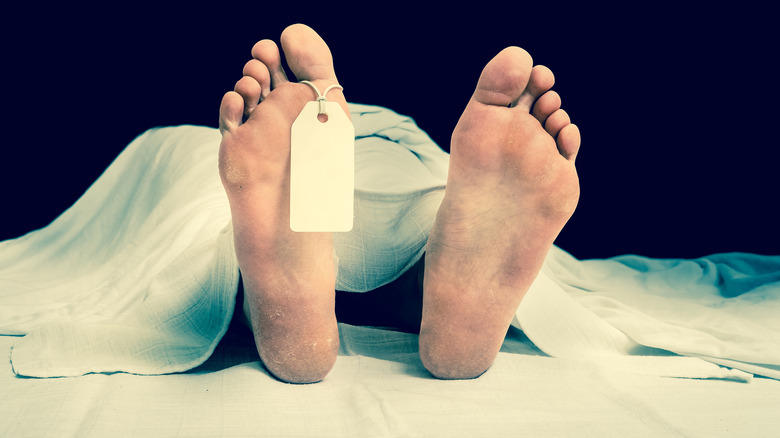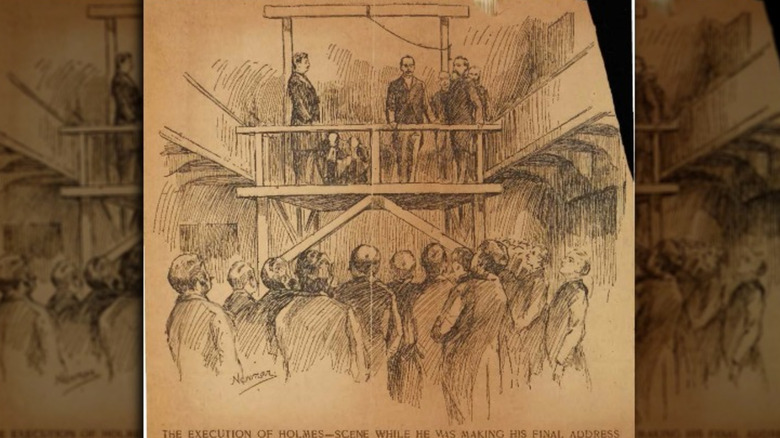The Morbid Thing H.H. Holmes Sold To Medical Schools
H.H. Holmes has the dark distinction of being among America's first serial killers. Born in Gilmanton, New Hampshire, Holmes committed his most infamous and deranged acts in Chicago, where he moved and found a job as a pharmacist in 1886, according to Crime and Investigation. In 1889, he began construction on his so-called "murder castle," into which he lured at least nine and possibly as many as 27 victims to their death (via History).
Holmes spent years building elaborate secret passages, false doorways, and staircases to nowhere at his hotel at 601-603 West 63rd Street. Construction on the hotel was elaborate and time-consuming. It was also costly. Although Holmes had made a fairly lucrative career out of running cons and scamming people, along the way he had also found another way to make some quick cash. Holmes had obtained his medical degree from the University of Michigan's Department of Medicine and Surgery, per Michigan Today. As a student, he had made quite a few connections with researchers and doctors, and he had one thing that medical schools at the time desperately wanted: human bodies. Taking advantage of his network, Holmes would sell the partially dissected bodies of his victims to medical schools, or strip the flesh from the corpses and sell the skeletons to medical supply houses, per Michigan Today.
Medical schools needed human cadavers for research
In the 1800s, performing medical research on real human bodies was difficult, as a decline in executions, as well as poor refrigeration methods, meant medical students had less access to fresh bodies that they could dissect and study, per PBS. However, medical schools were still desperate to get their hands on real cadavers for anatomical lessons, and they were willing to pay whenever someone came along with a fresh body for their research, They were even willing to turn a blind eye if it appeared the body had come into its owner's possession under nefarious circumstances — as quite a few of them did, seeing that really the only ways to get your hands on a dead body then were via grave robbing or outright murder, according to Smithsonian Magazine.
For Holmes, selling the bodies also provided an added benefit. At the medical school, the bodies would be poked, prodded, dissected, and generally manhandled, and whatever else remained was simply dissolved in lime or acid, per Mental Floss. It effectively destroyed much of the evidence of his crimes, enabling him to go on killing until a stolen horse finally led to him being caught and brought to justice in 1894.
That wasn't Holmes' first medical cadaver scheme
But that wasn't even the first money-making scheme Holmes' had concocted using medical cadavers. While he was a student, Holmes had gone the opposite way – taking the cadavers from the medical school's laboratory and then burning or disfiguring them. With the bodies mutilated beyond recognition, Holmes would then take out a life insurance policy on them before planting the body somewhere in an attempt to make it look as though they had died in an accident, so he could collect on the insurance money, according to Alcatraz Crime Museum.
This was the first among many insurance scams he would run throughout his life, most of them involving dead bodies. After medical school, Holmes would take out life insurance policies on a number of people, including his wives — he had three —
as well as employees and even the guests at his creepy hotel, making himself the beneficiary of all of them, so that when these people mysteriously turned up dead, Holmes would get the cash. Ironically, it was one of these types of scams that helped bring Holmes to justice, by way of a disgruntled criminal named Marion Hedgepeth.
An insurance scheme helped bring Holmes to justice
Holmes had been arrested in St. Louis in 1894, not for murder, but because of a different scam. He had been running a con stealing horses in Texas and then selling them for a tidy profit in Missouri, until the police got wise to his scheme and sent him to jail, according to Crime Museum.
Behind bars, Holmes' cellmate just happened to be none other than the famous Old West outlaw Marion Hedgepeth. Not one to take a day off, soon Holmes was concocting yet another scam with his new acquaintance. They decided Holmes should fake his own death, after taking out a $10,000 insurance policy on himself with Hedgepeth as the beneficiary, which they would then split. However, once he was released, Holmes decided that, rather than faking his own death, it would be easier to simply kill his old business partner Benjamin Pitezel and keep all the money for himself. Of course, that meant Hedgepath never got his cut. Angry that Holmes had never paid up, Hedgepeth decided to rat him out to the authorities, telling them all about their initial plan. This launched another hunt for Holmes, who authorities eventually turned up in Boston, thanks to an outstanding warrant they still had on him for stealing horses. Once he was arrested, the true nature of his gruesome crimes finally emerged, and he was hanged at the gallows in 1896.



